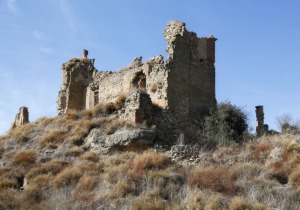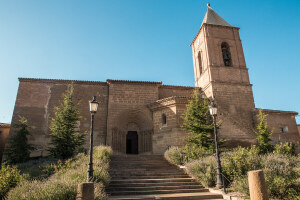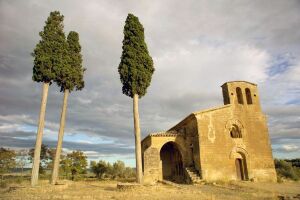There can be no better introduction to the exciting world of prehistoric life in High Aragon, than with an initial stop at the Rock Art Visitor Centre in Colungo. Here, you will find detailed information to direct you to the various caves and shelters of the River Vero canyon that have rock paintings. It is also possible to gain a great insight into the evolution of the primitive towns that once existed in the area and the cultural expression of their inhabitants.
(Please note that entry to the caves mentioned in this route is only allowed as part of a guided visit. Details are given by following the ‘Guided Visits’ link on the homepage of this website and also at the visitor centre in Colungo.)
In Colungo you should also take the opportunity to stroll around the labyrinth of narrow streets, which wrap themselves around the Gothic parish church; dedicated to Nuestra Señora del Pilar.
From Colungo, take the A-2205 towards Arcusa. This winding stretch of road provides stunning scenery, with the rock of the tree-covered slopes slashed by deep gorges. One of the better known of this area is the Fornacal gorge. At around 9 kilometres from Colungo and just before arriving at the San Caprasio ridge, you will find the starting point of a footpath leading to the Arpán Shelters and to the Fuente de la Trucha cave. A further 2.5 kilometres along the main road, there is a car park for those wishing to visit theTozal de Mallata caves.
After visiting the caves and still continuing on the same road, you will soon reach a viewpoint overlooking the Portiacha ravine, which shows the wild beauty of the Vero canyon at its very best.
Now in the district of Sobrarbe the route continues in the direction of the small village of Lecina, which boasts a town centre of great beauty and a medieval air. Of particular interest here is thethousand-year-old oak, which can be reached in just ten minutes along a pleasant path that leaves from the central square. This same square is also home to the Tourist Information Office, which will provide details of how to reach the Caves of Barfaluy.
Returning toward Colungo, this interesting route can be completed by visiting the small hamlet ofAsque. From here a number of excursions can be carried out; to the Regacens Shelter with its prehistoric paintings hidden under the overhanging rocks, or to Devil’s Bridge suspended over the Ravine of Las Gargantas.
Finally, you will arrive back to the starting point of Colungo. Another famous tree lies near the village - the great thousand-year-old olive tree of Nadal. Just a kilometre from Colungo in the direction of Barbastro, leave the car next to the farm on the main road. Cross the road and climb the small embankment to reach an orchard of almond trees; here you will see the ancient tree with its gnarled branches and hidden history.
This route reveals just a small slice of prehistoric life. From Alquézar or Radiquero there are footpaths leading to the other caves paintings in the shelters of Chimiachas and Quizans, which also take in the small hamlet of San Pelegrín.









